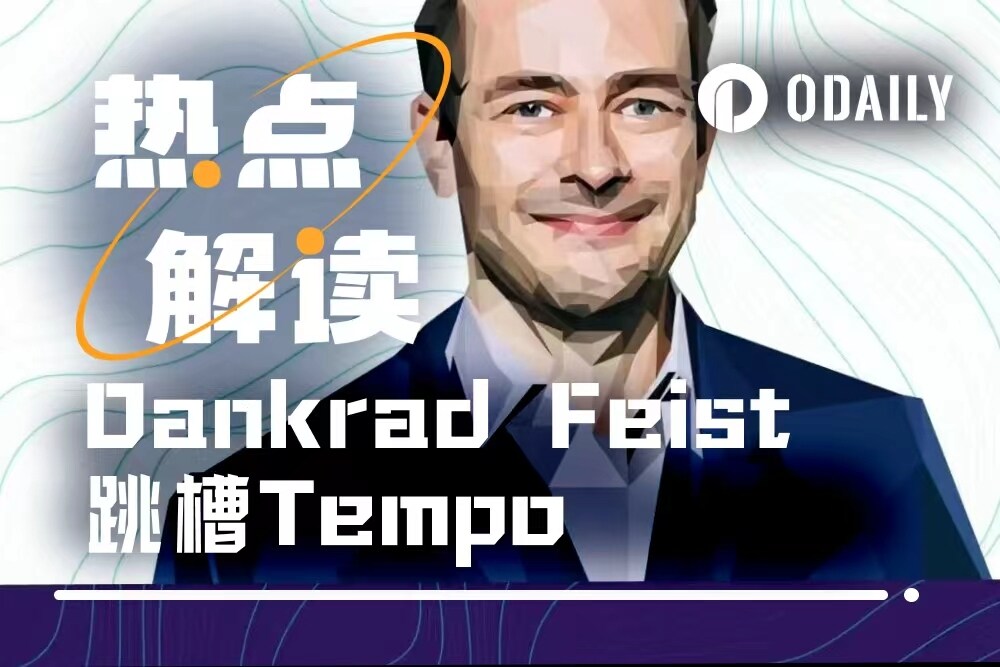Original | Odaily Planet Daily (@OdailyChina)
Author|jk
On October 17, 2025, a tweet sent the entire Ethereum community into a frenzy. Dankrad Feist, a core researcher at the Ethereum Foundation, announced on Twitter that he would be leaving his full-time position at the Ethereum Foundation to join a blockchain company called Tempo. The news quickly spread throughout the crypto circle, with even Ethereum founder Vitalik Buterin personally responding: "Dankrad has always been an outstanding researcher, making significant contributions to the Ethereum we know and love today, including Danksharding, consensus research, and more."
So, who exactly is Dankrad Feist, the person capturing the attention of the entire Ethereum community? From a PhD researching nuclear physics to the namesake of Ethereum's scalability solution, and now diving into the blockchain payment revolution, his story is nothing short of legendary.
A Decade of Transformation for a Scholar-like Tech Genius
If you think Dankrad Feist started out as a cryptocurrency enthusiast, you are mistaken. This German's academic journey began in the Department of Applied Mathematics and Theoretical Physics at Cambridge University, where Stephen Hawking once worked. In 2013, Feist completed his PhD in theoretical physics at Cambridge, focusing on Skyrmions—a mathematical model used to describe nuclear interactions. His dissertation delved into the "Interactions of B=4 Skyrmions," which are significant for understanding the behavior of alpha particles (helium nuclei).
This may seem unrelated to blockchain, but it is precisely this strong foundation in mathematics and physics that laid the groundwork for Feist's later breakthroughs in cryptography. During his PhD, he published papers involving complex numerical methods and multipole theory, skills that would later prove invaluable in designing blockchain scalability solutions.
Interestingly, while completing his PhD, Feist began to develop a "casual" interest in something called "Bitcoin"—in 2013, a pivotal year when Bitcoin began to move from geek circles into the public eye.
Entrepreneurial Interlude: From Scholar to Entrepreneur
After obtaining his PhD in 2013, Feist did not choose to stay in academia for a postdoc; instead, he decisively jumped into the tech industry. In 2016, he co-founded a health tech company called Cara Care, focusing on personalized digestive health solutions. Meanwhile, Feist's interest in cryptocurrency gradually deepened. From a "casual encounter" in 2013 to a more profound understanding of the mathematical and cryptographic foundations of blockchain, this process took several years. He began to realize that many challenges in blockchain technology—such as consensus mechanisms, cryptographic proofs, and network scalability—required the mathematical tools he was proficient in to solve.
Joining Ethereum: From Part-time Researcher to Core Contributor
In 2018, Feist began working part-time for the Ethereum Foundation. By 2019, he officially became a full-time core researcher. This decision changed the trajectory of his life and profoundly influenced the direction of Ethereum's development. At the Ethereum Foundation, Feist focused on scaling Ethereum, particularly in the areas of applied cryptography, secure multi-party computation (MPC), and zero-knowledge proofs. He quickly demonstrated the ability to translate complex theories into practical solutions.
"Danksharding": The Scalability Revolution Named After Him
Feist's most notable contribution is undoubtedly "Danksharding"—a sharding design scheme directly named after him. This design aims to improve Ethereum's data availability through an MPC-friendly custody proof protocol and a new sharding construction.
In simple terms, sharding involves splitting blockchain data into smaller pieces, allowing different nodes to process different parts, significantly enhancing the overall network's processing capacity. However, Feist's innovation lies in his design of a data availability sampling (DAS) mechanism, ensuring that even in a sharded environment, the network can verify that all necessary data is available.
The importance of this proposal cannot be overstated. Even Ethereum's EIP-4844 (referred to as "proto-danksharding") is named after Feist's contribution, marking a significant first step towards full sharding for Ethereum.
EIP-9698: A Crazy Proposal for 100x Scalability
If Danksharding showcased Feist's technical depth, then his EIP-9698 proposal made in April 2025 demonstrated his bold vision. This proposal suggests exponentially increasing Ethereum's gas limit by 100 times over four years, from the current 36 million to 3.6 billion.
If adopted, Ethereum could theoretically achieve a processing speed of 2,000 transactions per second, directly competing with high-performance chains like Solana. Feist's plan is to start on June 1, 2025, increasing the gas limit exponentially for each beacon chain epoch, roughly every two years by a factor of 10.
This proposal sparked intense discussions within the community. Supporters believe it could significantly enhance Ethereum's performance while maintaining decentralization, while critics worry it may put pressure on node operators. However, Feist's response was pragmatic: "The growth in each epoch of the exponential growth plan is gradual, giving node operators and developers ample time to adapt and optimize."
Other Technical Contributions: From Verkle Trees to Zero-Knowledge Proofs
In addition to these star projects, Feist has made in-depth contributions across multiple layers of the Ethereum tech stack. In the research of stateless Ethereum, he has been one of the key figures driving this critical technology forward, advocating for the use of Verkle trees—an advanced cryptographic data structure—to replace traditional Merkle trees, allowing nodes to verify transactions without storing the entire blockchain state, significantly lowering the hardware requirements for running Ethereum nodes.
At the same time, he has fully leveraged his strong mathematical background in the field of zero-knowledge proofs, investing considerable effort in KZG polynomial commitments and various zk-SNARK optimization techniques. These seemingly abstract cryptographic tools have now become the core technological foundation for Layer 2 solutions like Optimism and Arbitrum. Equally important is his pioneering work in data availability—his designed MPC-friendly data custody proof protocol addresses a critical issue in sharded environments: how to ensure that validators are indeed storing the data they are supposed to. This protocol allows validators to cryptographically prove they hold sharded data without needing to reveal all content, which is crucial for Ethereum's long-term scalability strategy.
Why Leave? "The Time for Payments Has Come" or "The Time for Money Has Come"
In his October 17 tweet, Feist wrote:
"I am excited to announce that I will be joining Tempo. The past year has been a turning point for the crypto industry, and we are finally seeing the outlines of the initial vision taking shape. Payments were core in the early days of crypto, and now I see a unique opportunity: as long as we persistently execute on both the technology and distribution fronts, we can finally achieve this ambitious goal.
I believe the moment to connect to the real world is now, and I want to ensure we do not miss this window to reach the lives of ordinary people globally. Over the past few years, I have focused on the architecture and scalability of blockchain; now I am excited to translate this experience into real-world results alongside the strong team Tempo is assembling…
Ethereum has a unique set of values and technical choices that make it stand out in the world. And Tempo will be an excellent complement: it is built on similar technologies and values while continuously breaking through in scale and speed. I believe this will greatly benefit Ethereum. Tempo's open-source technology can easily flow back and integrate into Ethereum, benefiting the entire ecosystem. Ethereum and Tempo are highly aligned, both idealizing permissionless. I look forward to continuing to participate in the community and pushing Ethereum forward!"
Notably, Feist emphasized that this is not a complete "farewell." He will continue to serve as a research advisor for the Ethereum Foundation, focusing on L1 scalability, blobs, and user experience improvements. In his view, Tempo and Ethereum are "strongly aligned" because they are both built on the same permissionless philosophy.
The Money Factor: The Pay Gap Between Nonprofits and Private Enterprises
While Feist emphasized the technical vision and timing in his public statement, the timing of his departure highlights a growing issue in the crypto industry: the salary competition for top talent.
According to a recent survey by Protocol Guild, the median salary for Ethereum core developers is only $140,000, and only 37% receive equity or token rewards from their employers. The report bluntly points out that Ethereum core developers "could earn double salaries in other blockchain projects."
More dramatically, just days before Feist announced his departure, Péter Szilágyi, a core developer of the Ethereum Geth client, publicly criticized the Ethereum Foundation's compensation policy, revealing that his total income over six years was only $625,000 (pre-tax), while Ethereum's market cap grew from nearly zero to nearly $450 billion during the same period.
According to salary data from Levels.fyi, the salary range at the Ethereum Foundation is between $117,000 and $155,000, with the median salary for software engineers being $155,000. In contrast, Coinbase's entry-level employees have a base salary of $150,000, plus $56,000 in stock and bonuses.
Tempo's situation is entirely different. The company recently completed a $500 million Series A funding round, with a valuation of $5 billion, clearly possessing the financial strength to offer competitive compensation packages.
Feist's departure "comes at a time when companies are increasing investments in building Layer-1 blockchains," reflecting the trend of the private sector actively poaching top blockchain talent. Notably, Feist and his colleague Justin Drake faced controversy over conflicts of interest for accepting advisory positions at EigenLayer in 2024, ultimately having to withdraw from those positions. This highlights the Ethereum Foundation's strict limitations on external income sources.
So, perhaps this job switch is indeed about the money.
Tempo: A New Attempt at a Payment-Specific Blockchain, a King-Level Project
So, what is Tempo? A blockchain project co-incubated by payment giant Stripe and crypto investment fund Paradigm, it is indeed a king-level project.
In October of this year, it completed a $500 million Series A funding round, with a valuation of $5 billion, making it one of the largest financings in the crypto space in 2025. But more importantly, it has a technological vision: a blockchain specifically optimized for payment scenarios. Unlike general-purpose blockchains like Ethereum, Tempo has been optimized from the start for high-frequency, low-cost stablecoin payments. Its goals sound somewhat crazy: to process over 100,000 transactions per second, with transaction confirmation times of less than 1 second.
To achieve these metrics, Tempo has made many innovations in its technical architecture: users can pay transaction fees directly with stablecoins, without needing to hold special tokens; it supports transaction notes compliant with the ISO 20022 standard, facilitating corporate reconciliation; it offers batch transfer functionality, suitable for payroll and other scenarios; and it includes optional privacy protection and compliance tools.
Looking back at Feist's career trajectory, you will notice an interesting pattern: he always makes transitions at key points of technological maturity. From theoretical physics to health tech, from entrepreneurship to blockchain research, and then from the Ethereum Foundation to the payment-focused Tempo, each transition has perfectly captured the window of opportunity in technological development.
This transition from fundamental research to concrete application also reflects the overall trajectory of the blockchain industry: moving step by step from the proof-of-concept stage to large-scale practical application.
免责声明:本文章仅代表作者个人观点,不代表本平台的立场和观点。本文章仅供信息分享,不构成对任何人的任何投资建议。用户与作者之间的任何争议,与本平台无关。如网页中刊载的文章或图片涉及侵权,请提供相关的权利证明和身份证明发送邮件到support@aicoin.com,本平台相关工作人员将会进行核查。



